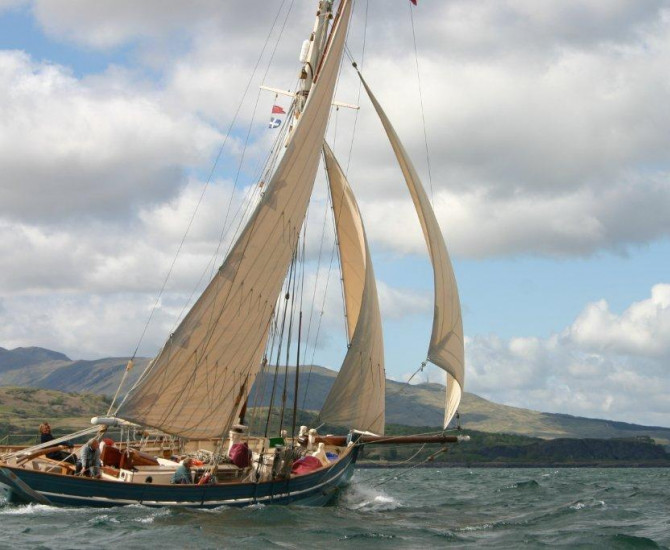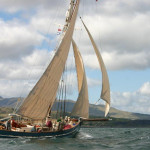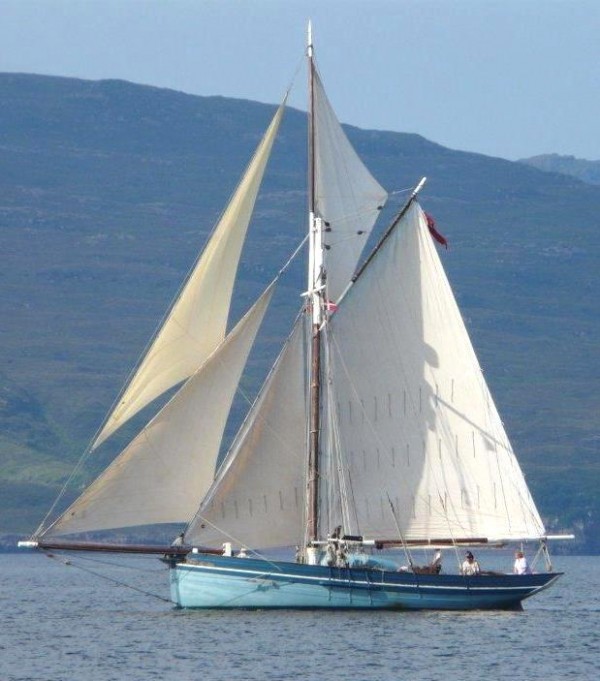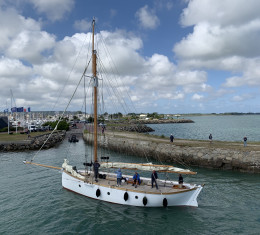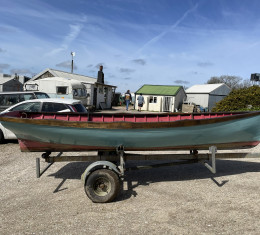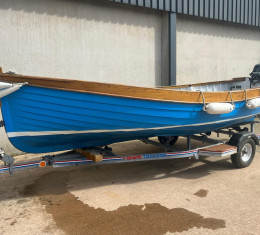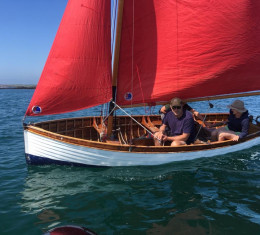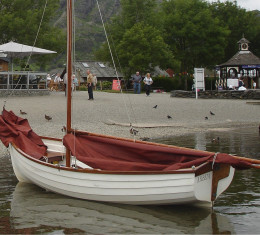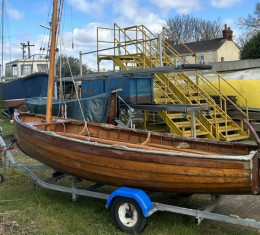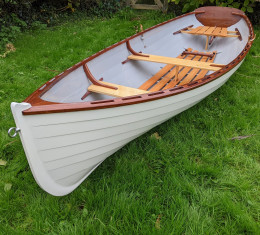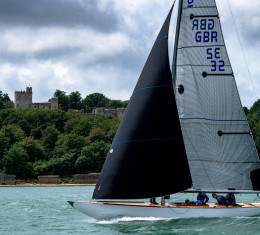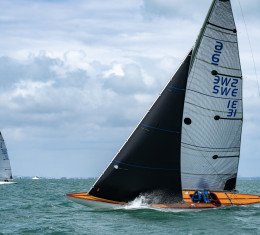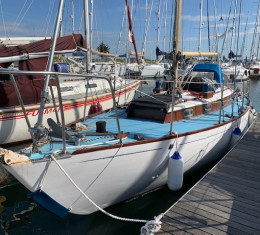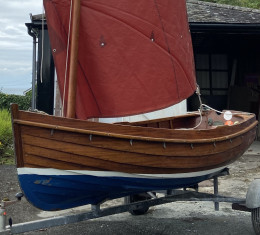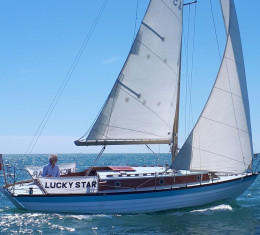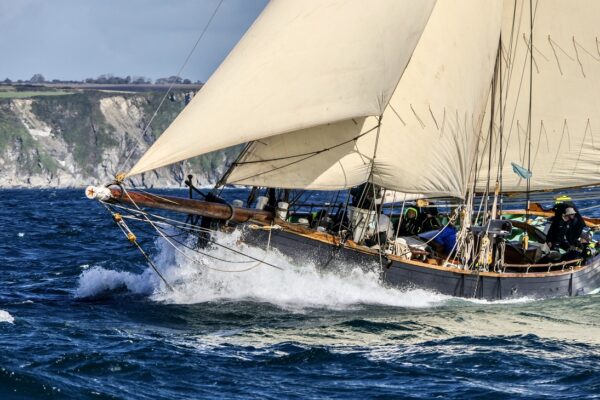Sailing yachts
Full specification
Wooden ships comments on this Luke Powell Isles Of Scilly Pilot cutter
A virtually new Luke Powell Luke Powell Isles of Scilly Pilot Cutter.
Boat builder Luke Powell of Working Sail, Cornwall has become a personal phenomenon. In the past few years he has almost single-handed created the reincarnation of the traditional pilot cutter type.
Starting earlier than the more famous Bristol Channel Pilot cutters, the Scilly Islands pilots were already building boats for the job in the mid 19th century, fine sea-worthy cutters with a distinctive counter, square fore foot and bow sections sharp enough to fillet a mackerel.
Luke used these early cutters as his inspiration and to date has built 8 boats varying in size from 38’ to 45’.
He builds in the totally traditional fashion, plank on heavy sawn frames all held together with gurt big nails, caulked and payed and finished to a high class working boat standard. His are boats to be sailed as well as admired. They are remarkably fast, their owners are full of enthusiasm for the way they sail and handle and they just look so good.
Every boat is different. He drew the lines for this one, built a half model to take off the moulds in the old way and started the build in the Spring of 2004. She was launched at Gweek Quay in March 2006 (see Classic Boat article). After a week of commissioning, she sailed north to start her life as a skippered charter vessel on the West Coast of Scotland.
In 6 years of the present first ownership, she has proved to be an exceptionally seaworthy, safe and a successful charter boat operating in the harsh conditions of the NW Coast of Scotland, the Northern Isles, Norway and the Atlantic coast of Ireland.
Construction
Hull Full displacement hull shape with good hull form stability, a long straight keel with good rise of floors to give a fine long runs aft. Such refined traditional lines give an extremely seaworthy vessel, fast in light airs, stiff in a breeze and powerful to windward. Traditionally built in conventional plank on heavy sawn oak frames, all caulked and payed.(See lines drawings and build pictures)
Back-bone The keel, stem and stem post are in Opepe, a sustainable West African hardwood, 7 ½” wide x 14” deep giving enormous strength to the vessel’s backbone. The deadwood assembly in the bow and stern built up in great lumps of timber is all through fastened with 7/8” diameter copper bar and riveted.
Frames English Oak sawn frames cut from from grown oak limbs chosen for their shape so that the grain runs true round the curve. The frames are assembled in pairs of futtocks 3” x 5” pinned together with ½” copper dumps giving a frame section of 6” x 5” at 18” centres to form a very robust hull.
Floors Massive oak floors across the centre-line bolted to the moulded faces of every frame.
Planking The garboard, second and third strakes are full length Scottish larch, 1 ¾” thick. Above, the planking is 1 5/8” with the top three strakes in oak and thicker at 2” to give the vessel extra longitudinal strength and durability.
Plank fastenings are all bronze screws, three per frame and wooden plugged.
Ballast Full length external lead ballast keel comprises 60% of the vessel’s ballast with a 7/8” bronze keel bolt every 18” through the oak floors and the back-bone. The remaining 40% of weight is trimming ballast in the form of lead ingots fastened in the bilges across the keel. The ballast ratio is 45% of the vessel’s displacement.
Topsides. Good freeboard with high bulwarks on oak stanchions gives a great sense of security on deck and the feel of a real little ship. The oak cavil rails across the stanchions with belaying pins give ample space to make fast halyards and mooring ropes. Additional belaying pins on a three-sided fife rail around the mast. The vessel’s name and port of registry are carved in the transom.
Deck. The deck is 1 ½” x 3 ¾” hardwood, straight laid to a wide cover-board around the deck edge, the seams caulked and payed with Sikaflex and left scrubbed. All fastenings are plugged.
Windlass & anchor. The antique design, hand spike barrel windlass is a major feature on the foredeck. This consists of an oak barrel thwart-ships with a double pawl on the central bowsprit bitt operated by oak bars placed in the slots on the port side, pulling in the chain to starboard. This is easily operated by one or two people. The windlass can also be used for raising the topmast, shipping and setting the bowsprit and tensioning the bobstay. 75lb CQR anchor with 110 metres of 5/8” chain.
Coach roof and hatches. Small midships coach-roof built to a very traditional design with opepe coamings and deck and finished in white paint. Two bronze opening port holes each side. The varnished cabin hatch on the coach-roof is built with fielded panelled sides, twin doors and a sliding top. Forward of the coach-roof between it and the mast is a traditional skylight with two opening fitted with 8mm laminated glass and brass protective bars. On the fore deck, the fore hatch opens forward giving easy access to the sail locker and fore cabin.
Steering. Oak tiller with the vessel’s name carved each side. Oak steering thwart extends the full beam of the vessel giving the helmsman a seated position on a flush deck. A compass binnacle is mounted on deck on a wooden plinth forward of the tiller. The engine controls are mounted beneath the thwart.
Rig Gaff cutter rig which over the centuries has proven to be the most powerful and efficient rig for fast, heavy displacement vessels. The thrill of sailing these vessels is that they handle like a dinghy spinning around the one mast when tacking but have the immense sense of power when driving forward under a press of canvas.
Spars Solid Douglas Fir mast, a tree grown north of Ashburton, Devon. The bowsprit is also solid Douglas Fir. The boom, gaff and topmast are laminated from 3” thick Canadian Fir to give them more rigidity and strength in their smaller sections. The mast bands and iron work for the rig are galvanised.
Rigging The wire standing rigging is 16mm galvanised for the lowers and 10mm for the uppers. All traditionally spliced and served in the time honoured way finished with wooden deadeyes and lanyards. The running rigging is of three strand hemp style polyester rove through ash pulley blocks ranging between 5” and 7”, some fifty in all.
Sails The suit of sails are in cream clipper canvas (a synthetic flax) traditionally made by Patrick Selman of Falmouth and beautifully finished with hand sewn bolt rope and reefing points. Mainsail, Topsail, staysail and jib. Additionally for lighter wind sailing there is a large jib and jib topsail. Boat cover A full boat cover also made by Patrick Selman protects the boat from the worst of the winter weather.
Interior The interior is fitted out to a high standard with varnished oak structure and painted pine panelling. The doors are fielded panels and the general air is spacious and light with ample headroom. At the bottom of the companionway a barometer and clock from William Forbes, Liverpool are mounted on the deck beam. (See Interior pictures).
Aft Aft of the companionway there are two double quarter berths, one each side.
Galley The galley is to port at the foot of the companionway. Large oak work surface with stainless double sink and mixer tap. A range of deep panelled cupboards behind for food storage and cupboards underneath for pots and pans. Force 10 large gas cooker on gimbals. Top loading refrigerator. Gas is stowed on deck in two 3.9kg or 6kg propane bottles.
Chart table The oak chart table is to starboard, facing forward, and is large enough for an admiralty chart. There is ample shelving for pilot books, wall space for electronics and drawers beneath.
Saloon The saloon is spacious with plenty of headroom and well lit from a large skylight. There is seating on both sides around a solid oak table with folding leaves and drinks locker within. Seating to starboard is deep and forms a snug by the wood burning stove also to starboard. To port there is an enclosed pilot berth and a floor standing Little Cod cast iron solid fuel stove by Navigator Works to starboard. To starboard also a full length oak bookshelf and plenty of stowage behind and beneath the seating. The general feel of the saloon is open plan with substantial oak posts dividing it from the galley/chart table area and oak trim around cream panelling.
Fore Cabin Passing forward of the mast on the starboard side a small corridor leads into the fore cabin. There are two berths on each side sleeping up to four people and including plenty of stowage and wet locker space. Bronze prism deck lights to port and starboard illuminating this area. A fore hatch gives easy access and provides extra light through a bronze deadlight.
Heads Enclosed shower/toilet to port with draining shower tray and grating, hand basin with mirror, cupboard and Jabsco regular sea toilet. This area is also illuminated with a deck prism.
Plumbing A pressurised hot and cold water system, heated by the engine, gives ample hot water to the shower and galley. 600 litres of drinking water is held in stainless steel tanks abreast of the engine. Bronze sea-cocks are used for all the hull fittings and are easily accessible internally. Bronze fillers are fitted for the diesel and water on deck.
Bilge Robust hand bilge pump located by the helm. Automatic electric bilge pump with float switch. Grey water from the sinks and shower is contained in a holding tank below the saloon floor and pumped out using a Jabsco whale pump located under the aft seat on the port side in the saloon.
Electrical System Electrical system includes brass cabin lights, chart light, brass bunk reading lights, comprehensive fuse panel and navigation lights. 2 x 12v heavy duty deep cycle batteries – one for services and one for engine start.
Electronics at chart table: Furuno GPS GP-32 Furuno Navtex NX-300 Raymarine Depth ST-50 Icom VHF IC-M421
On deck Raymarine ST50 Repeater (with wooden cover) shore power socket x2 12v. sockets – one at mast & one at thwart
Below deck Sterling Inverter shore power immersion heater 240 v. outlets at chart table and in engine bay x2 12v. cigar lighter sockets at chart table
Engine A Beta 62.5hp 5 cylinder marine diesel engine is fitted with bronze stern tube and bronze three bladed fixed propeller. PRM260 hydraulic gearbox is installed. Engine hours 2080 at September 2011.
Fuel. Two x 175litre stainless steel tanks situated either side of the engine and fitted with dipsticks. Insulated engine compartment with removable panels for easy access to engine. Engine control panel by chart table with key start, oil pressure warning and rpm counter. Three sacrificial anodes are fitted for the engine, stern tube and rudder pintles. The engine has been maintained since new with the BETA service schedule strictly adhered to.
Maintenance. Maintained good working order throughout the season and under cover in the winter. Halyards and sheets have been replaced as required, ash blocks maintained, and all paintwork kept up. Above deck there is no varnish and all the bright work is treated with Danish oil mixed with Stockholm tar.
MCA Code Certified for the MCA SCV Code 2 (60 nm from a safe haven) since build and was supervised through the build by surveyor Tony Head, Surveyor of Plymouth. She is coded for 8 passengers (including crew) for overnight voyages and 10 passengers for day voyages. 5 year survey in March 2011. Full safety equipment compliant with or exceeding the requirements of the Code. This includes: SOLAS ‘B’ 10 man liferaft 2 x lifebouoys – both with lights and one with throw rope and one with inflatable danbuoy full length jackstays x12 lifejackets EPIRB fire extinguishers x4 dry powder smoke alarms; gas alarm; bilge alarm flares
Wooden Ships classic yachts brokers have an extensive database of boats for sale. With a wide range of sailboats, classic yachts, motor yachts and small classic boats, Wooden Ships has one of the largest selections of traditional wooden boats and yachts for sale in the UK.
Disclaimer:
These particulars have been prepared in good faith from information provided by the Vendors and are intended as a guide, Wooden Ships cannot guarantee or warrant the accuracy of this information nor warrant the condition of the vessel. The Purchaser should instruct his agent or surveyor to validate all details as necessary and satisfy himself with the condition of the vessel and its equipment.

